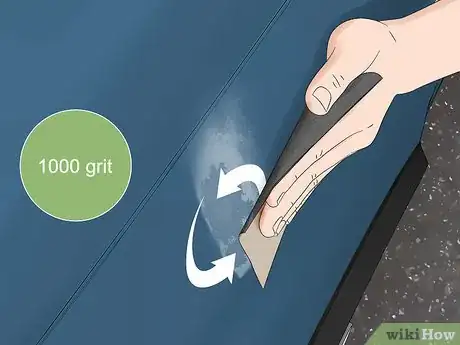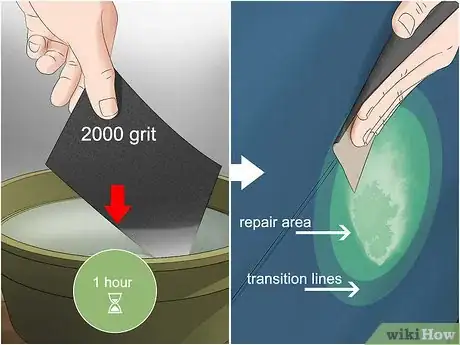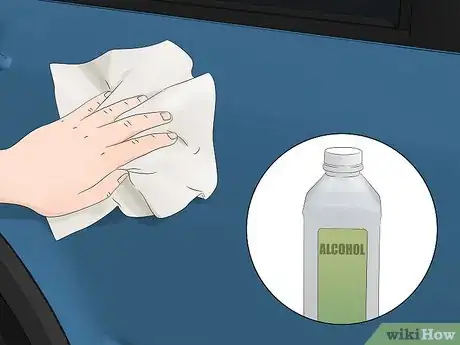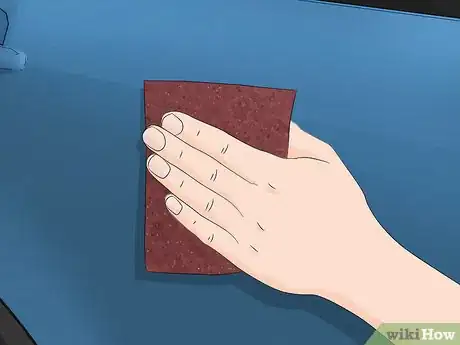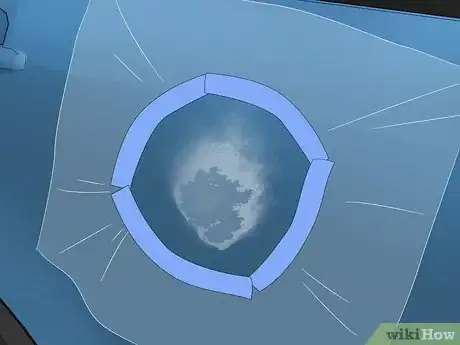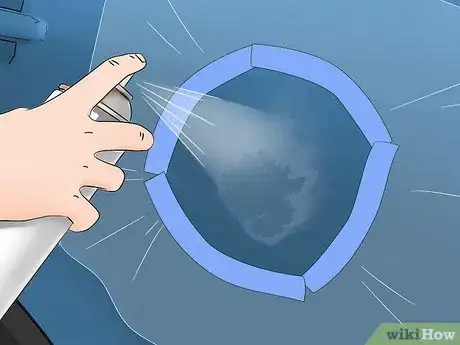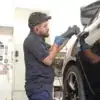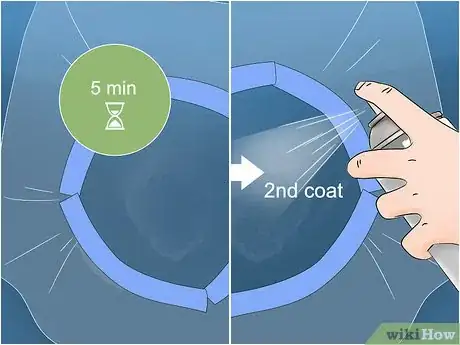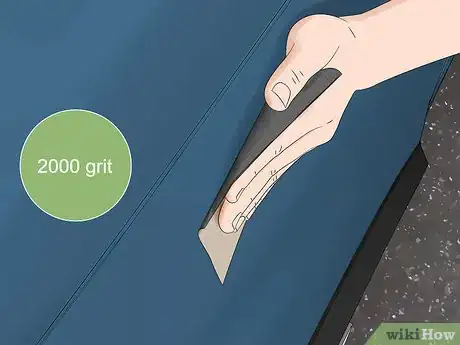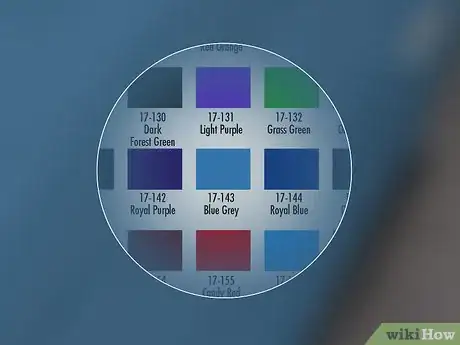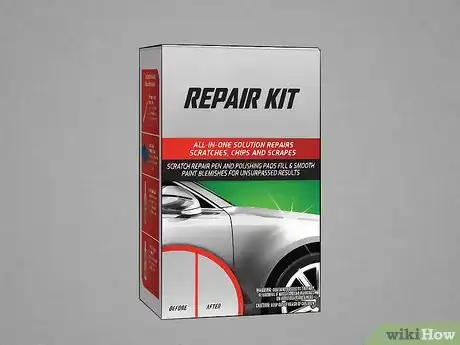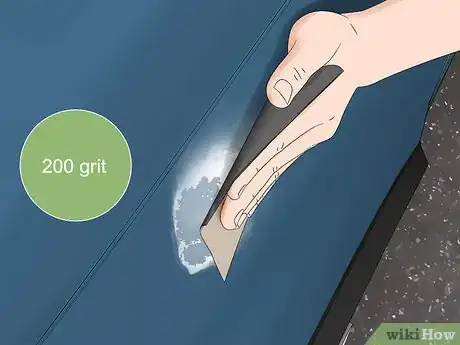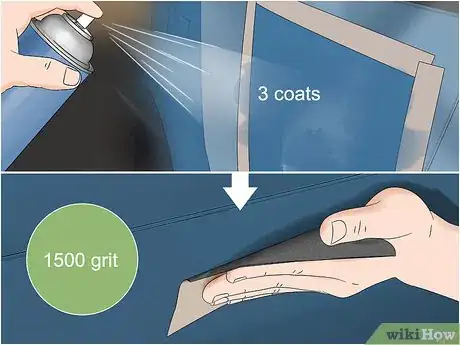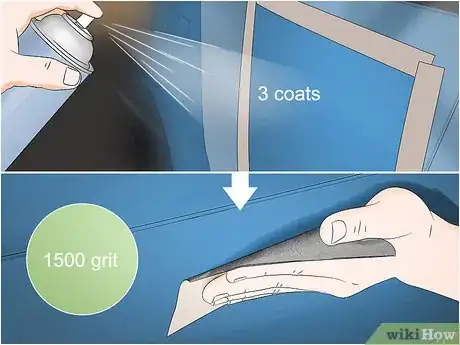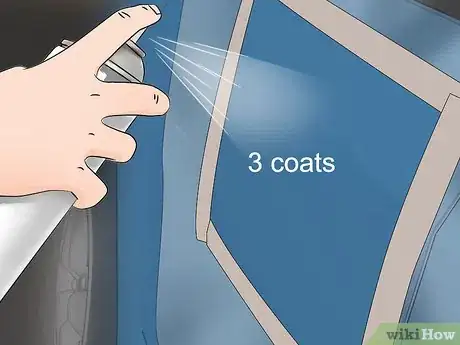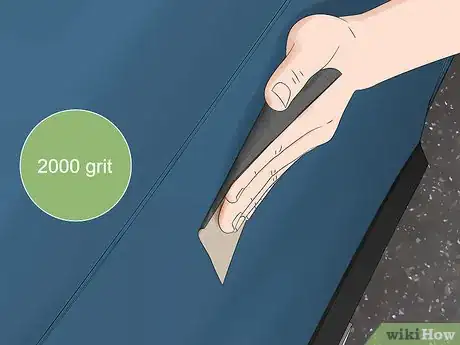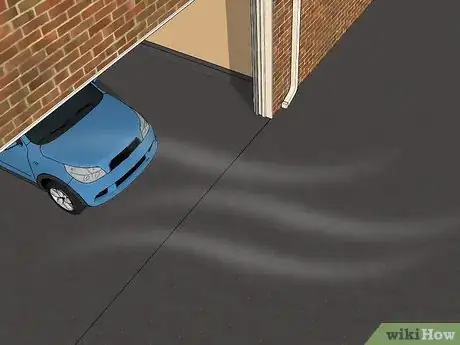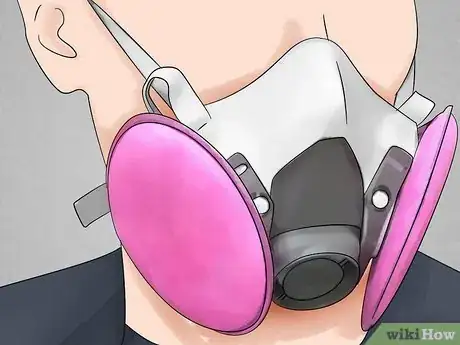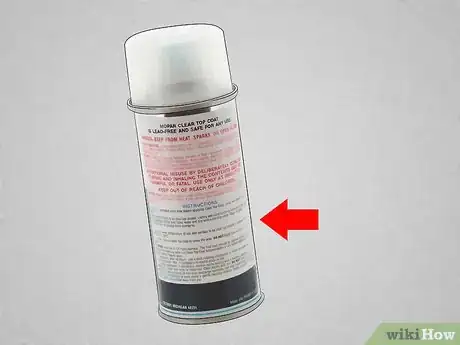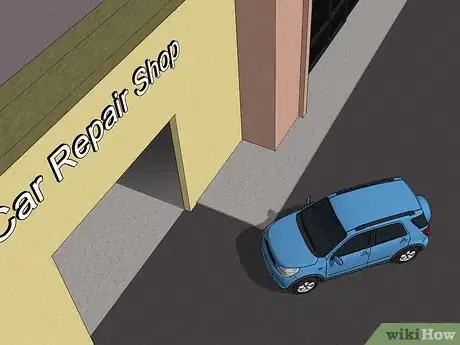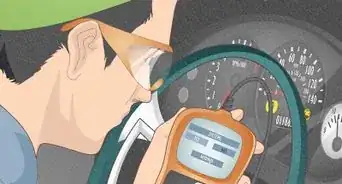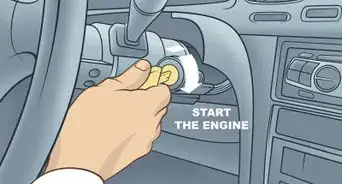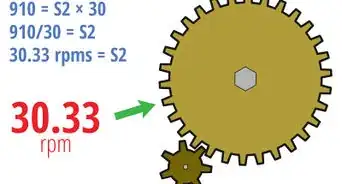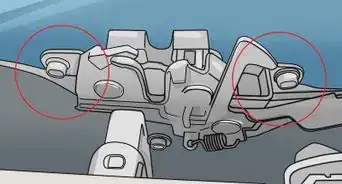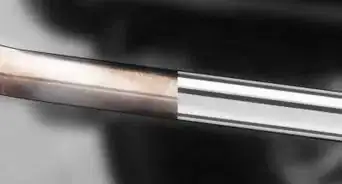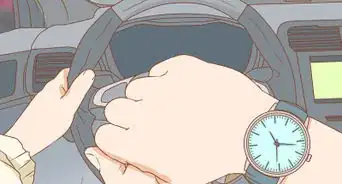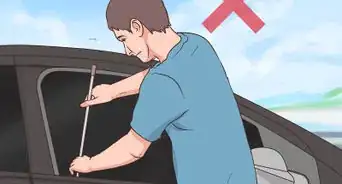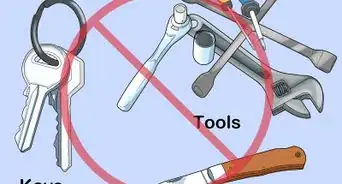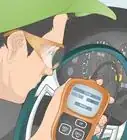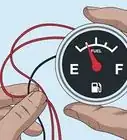This article was co-authored by Angel Ricardo and by wikiHow staff writer, Christopher M. Osborne, PhD. Angel Ricardo is the owner of Ricardo's Mobile Auto Detail headquartered in Venice, California. With over 10 years of experience in mobile detailing, Angel continues to attend auto detailing trainings to improve his customer service and auto detailing skills.
wikiHow marks an article as reader-approved once it receives enough positive feedback. In this case, 93% of readers who voted found the article helpful, earning it our reader-approved status.
This article has been viewed 454,205 times.
You still love your older car, but it’s starting to look its age. The paint job's glossy shine might be marred by bubbles and blisters of the clear coat finish. This is known as delamination, and the best fix for widespread cases is a pricey repainting job. Or, if you have some experience with automotive painting, you can use professional tools like a compressed air gun to apply new clear coat. However, if the peeling is limited in scope—for instance, spots on the hood or near the wheels—making spot repairs with an aerosol spray can is a manageable DIY project.
Steps
Replacing Only the Peeling Clear Coat
-
1Scrub the damaged area with 1000 grit sandpaper. Rub the sandpaper in circles, pressing firmly. Sand a little beyond the original damage, even if it means peeling away a small amount of clear coat that is still in decent condition.[1]
- If the pigmented paint below the clear coat is still in good shape, don’t scrub so hard that you remove it as well.
- If the clear coat is already gone, skip this initial sanding and go straight to wet sanding and cleaning.
-
2Wet sand the transition between your work area and the remaining clear coat. Use 2000 grit sandpaper that’s been soaking in water for an hour. Smooth out the transition lines between your repair area and the surrounding clear coat. Keep the sandpaper wet by dipping it in water as needed.[2]
- Straighten out or square off the work area when you can, as this will make it easier to tape off the area later.
Advertisement -
3Clean the clear coat-free area with alcohol and solvent-based cleaners. Use an alcohol-based cleaner, like glass cleaner, to clean the area you just sanded. Follow this up with a solvent-based paint prep cleaner, which will either come with your chosen clear coat repair kit or be found alongside the clear coat sprays.[3]
-
4Scuff the cleaned area with a fine grit, woven scuffing pad. These pads are similar to the ones you might use on your dirty pots and pans in the kitchen, and are available at automotive supply retailers. Don’t use steel wool or sandpaper. You just want to give the pigmented paint a slightly rough texture.[4]
- Clean the area afterward with the solvent-based cleaner.
- Skip this step if the paint is already scuffed up from your earlier sanding.
-
5Tape off the work area with easy-to-remove masking tape. Stick the tape to your pants and peel it away once or twice to make it less sticky. Create a taped-off area around the removed clear coat that's slightly larger than the actual damaged area. Use plastic sheeting and more tape to expand the outside of the protective zone, so that your clear coat spray only lands on the car where intended.[5]
-
6Spray the aerosol can of clear coat onto the surface.[6] Shake the can as instructed on its label. Also refer to the label for the optimal spraying distance and motion. Keep moving as you spray so that you create an even layer. Let this first coat dry for at least 5 minutes, or for the time recommended on the can.[7]
- You may be instructed to go over each dried coat with very fine sandpaper (e.g., 1500 or 2000 grit, possibly soaked with water). Follow the instructions on the spray can, and wipe away dust and debris with a tack cloth.
-
7Apply a second layer of clear coat in the same manner. Two coats is usually sufficient, but follow the instructions on the can. Let each coat dry for at least 5 minutes before applying the next one.[8]
- Remove the tape and plastic sheeting after the last coat dries.
- Wait several hours, or overnight, before finishing off the repair.
-
8Blend in the repaired area with the surrounding car finish. Lightly go over the repaired area with 2000 grit sandpaper. Then, use a polishing compound and a motorized buffer to blend the transitions and make your repair work vanish as much as possible.[9]
- Buff the area by hand if you need or want to, but expect to have a sore arm the next day!
Replacing the Color Coat and the Clear Coat
-
1Find your car’s factory paint color code. If the peeled clear coat has caused the exposed color coat to fade, scratch, or peel, you’ll want to address the pigment problem as well. Search your car for a tag with a paint code — for instance, M1724A for a black 1993 Ford Bronco — for the factory-applied pigment.[10] Start by opening the driver’s side door and looking below the latch, then move on if needed to common placement spots like under the hood or in the trunk.[11]
- If you can’t find the paint code, you can search by your car’s make, model, and year online or at an auto parts retailer. Or, you can try to match the color by bringing a sample — for instance, the door that covers your gas cap — to a store that carries automotive paints.
-
2Invest in an all-in-one touch-up kit. For the most convenient DIY solution, choose an all-in-one automotive touch-up kit that provides everything from sandpaper and tack cloths to the different pigment and clear sprays you’ll use. Use your paint code to order a kit that is custom colored to match your vehicle’s factory paint job.[12]
- If you buy the individual components yourself you’ll need primer, pigment, and clear coat sprays; sandpapers of varying grits (often ranging between 200 and 2000 grit); alcohol and solvent based cleaners; and tack cloths to remove dust and debris. Other items may be required depending on the instructions for the paint products you choose.
-
3Sand the peeled area down to the bare metal or base material. Use the heavier grit sandpaper (e.g., 200 grit) that comes with your kit. Wipe away flakes and dust with a tack cloth, then clean the area with the provided cleaner(s).[13]
- When you’re done sanding and cleaning, tape off the prepared area as advised in the kit. Or, use plastic sheeting and masking tape with reduced adhesion (stick it to and peel it from your pants once or twice first).
-
4Apply approximately 3 coats of automotive primer. Follow the precise instructions on the kit or can. 3 coats is common, but you may be advised to use fewer or more coats. Allow the primer to dry between coats. Then, use a fine grit sandpaper (1500, for instance) to lightly scuff the surface. Wipe it with the tack cloth before adding the next coat.[14]
-
5Apply the instructed number of pigment coats. Once again, 3 is the typical number of coats. Between each coat, keep using fine grit sandpaper (once the paint has dried) and wipe away dust with a tack cloth.[15]
- Use a smooth, steady spraying motion to get even coats of paint. Follow the product instructions regarding spraying distance and technique.
- Make sure you are spraying in a well-ventilated area.
-
6Finish the paint job with multiple rounds of clear coat.[16] You’ll probably be instructed to apply 2 or 3 coats of clear coat. In between coats, you’ll also need to use very fine sandpaper, possibly wet-sanding with 1500 or 2000 grit paper. Soak the paper in water and dip it as needed when wet sanding.[17]
- Allow the final clear coat application to dry overnight before proceeding.
-
7Buff the repaired area to blend it in. Lightly go over the area with 2000 grit sandpaper, then use polishing compound and a motorized buffer. You can buff by hand instead, but the transition between the old and new clear coat will be more obvious.[18]
Being Safe and Realistic
-
1Set up a fresh air ventilation system for your work area. Don’t ignore the dangers of the chemical-laden dust particles and fumes created by repairing an automotive clear coat. Make sure there is plenty of fresh air circulating through your workspace. Repairing clear coat outdoors isn’t ideal due to the many variables like sunshine, precipitation, and wind-blown dust and debris, but a garage with open doors and windows will do. Adding exhaust and circulating fans is even better.[19]
-
2Wear breathing protection at all times. No matter how well ventilated your work area is, you need to protect your lungs from dust and chemicals. Skip the thin surgical mask and invest in an activated charcoal facemask.[20]
- Wear eye protection that will keep out dust and fumes as well. This means goggles, not glasses.
-
3Follow the instructions provided with your chosen repair product. There are many different types of automotive clear coat repair sprays, and each will have its own particular directions regarding surface preparation, spray technique, drying times, number of coats, and so on. Read these instructions before you start sanding or spraying.[21]
-
4Have your car professionally repainted for the best results.[22] The DIY products on the market can do a nice job of replacing bubbling and peeling clear coat spots. However, a close inspection will always reveal differences between the original paint job and the repaired areas. If you don’t want there to be any evidence of repairs, you’ll need to take your car in for a professional repainting job.
- The pros will strip away everything to the bare metal or fiberglass and repaint the entire area. They may be able to repaint a single section, like the hood, or it may be necessary to repaint the entire car. This can cost several thousand U.S. dollars.
Expert Q&A
Did you know you can get expert answers for this article?
Unlock expert answers by supporting wikiHow
-
QuestionCan you fix small clear coat peeling yourself?
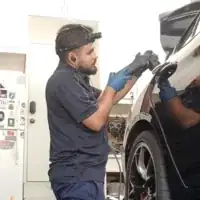 Angel RicardoAngel Ricardo is the owner of Ricardo's Mobile Auto Detail headquartered in Venice, California. With over 10 years of experience in mobile detailing, Angel continues to attend auto detailing trainings to improve his customer service and auto detailing skills.
Angel RicardoAngel Ricardo is the owner of Ricardo's Mobile Auto Detail headquartered in Venice, California. With over 10 years of experience in mobile detailing, Angel continues to attend auto detailing trainings to improve his customer service and auto detailing skills.
Auto Technician
References
- ↑ https://garage.eastwood.com/eastwood-chatter/how-to-repair-clearcoat-defects/
- ↑ https://garage.eastwood.com/eastwood-chatter/how-to-repair-clearcoat-defects/
- ↑ https://garage.eastwood.com/eastwood-chatter/how-to-repair-clearcoat-defects/
- ↑ https://garage.eastwood.com/eastwood-chatter/how-to-repair-clearcoat-defects/
- ↑ https://garage.eastwood.com/eastwood-chatter/how-to-repair-clearcoat-defects/
- ↑ Angel Ricardo. Auto Technician. Expert Interview. 1 October 2019.
- ↑ https://garage.eastwood.com/eastwood-chatter/how-to-repair-clearcoat-defects/
- ↑ https://garage.eastwood.com/eastwood-chatter/how-to-repair-clearcoat-defects/
- ↑ https://garage.eastwood.com/eastwood-chatter/how-to-repair-clearcoat-defects/
- ↑ http://www.popularmechanics.com/cars/how-to/g173/how-to-fix-a-car-paint-scratch/#fbIndex1
- ↑ http://autotrends.org/2012/06/13/how-can-i-find-my-car-paint-code/
- ↑ http://www.automotivetouchup.com/
- ↑ http://www.popularmechanics.com/cars/how-to/g173/how-to-fix-a-car-paint-scratch/#fbIndex1
- ↑ http://www.popularmechanics.com/cars/how-to/g173/how-to-fix-a-car-paint-scratch/#fbIndex1
- ↑ http://www.popularmechanics.com/cars/how-to/g173/how-to-fix-a-car-paint-scratch/#fbIndex1
- ↑ Angel Ricardo. Auto Technician. Expert Interview. 1 October 2019.
- ↑ http://www.popularmechanics.com/cars/how-to/g173/how-to-fix-a-car-paint-scratch/#fbIndex1
- ↑ http://www.popularmechanics.com/cars/how-to/g173/how-to-fix-a-car-paint-scratch/#fbIndex1
- ↑ http://www.popularmechanics.com/cars/how-to/g173/how-to-fix-a-car-paint-scratch/#fbIndex1
- ↑ https://garage.eastwood.com/eastwood-chatter/how-to-repair-clearcoat-defects/
- ↑ http://www.popularmechanics.com/cars/how-to/g173/how-to-fix-a-car-paint-scratch/#fbIndex1
- ↑ Angel Ricardo. Auto Technician. Expert Interview. 1 October 2019.
About This Article
To fix a peeling clear coat on your car, start by scrubbing the peeling area with 1000-grit sandpaper to get rid of the damaged coat. Then, soak 2000-grit sandpaper in water for an hour before sanding around the damage to blend the repair area with the clear coat. Once you’ve sanded your car, clean the space with an alcohol-based cleaner, like glass cleaner, and scuff it with a fine grit, woven scuffing pad. After you’ve cleaned the area, tape around it with masking tape to mark out your working space. Next, spray an aerosol can of clear coat onto the surface. Let it dry for 5 minutes, then spray on a second coat. To finish off, remove the masking tape, then lightly go over the area with 2000-grit sandpaper to blend your new coat with the old one. For more tips, including how to replace your car’s underlying color coat, read on!
